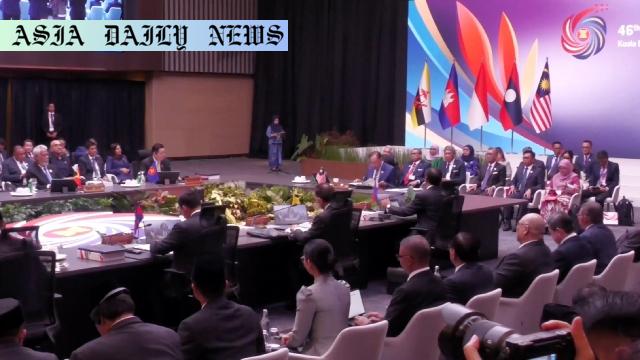Myanmar Ceasefire – ASEAN leaders urge an extended and expanded ceasefire in Myanmar to address escalating conflicts and humanitarian crisis.

ASEAN’s Urgent Call for Myanmar Ceasefire Extension
The Association of Southeast Asian Nations (ASEAN) leaders have strongly called for an extended and expanded ceasefire in Myanmar, following the temporary truce declared after the massive earthquake that struck the country in March 2023. This plea came after the conclusion of ASEAN’s summit talks in Kuala Lumpur, where the deteriorating situation in Myanmar took center stage. Since a military coup in 2021, Myanmar has been engulfed in severe internal conflict between the military junta and civilian pro-democracy forces. The ongoing strife has only compounded an already dire humanitarian crisis.
In their joint statement, ASEAN leaders expressed their deep concern over escalating violence and civilian suffering in Myanmar. The temporary ceasefire, initiated to enable relief operations after the earthquake, was a significant gesture amid the unrest. The leaders emphasized the importance of maintaining this ceasefire, not just as a short-term relief effort but as a foundation for broader peace. They called for an immediate halt to violence targeting civilians, public institutions, and critical infrastructure while advocating for a sustainable, nationwide cessation of hostilities. The ultimate goal, they emphasized, is fostering dialogue and achieving a peaceful resolution to Myanmar’s crises.
The Devastation of Myanmar’s Earthquake
Myanmar’s troubles were further exacerbated when the 7.7-magnitude earthquake devastated central regions of the country in March 2023. The disaster left over 3,700 dead, thousands injured, and countless others displaced. Survivors continue to struggle in makeshift shelters and inadequate housing, underscoring the urgent need for humanitarian aid. To address this, ASEAN is rallying not only its member states but also the international community to step in with long-term relief and reconstruction efforts. Among the most vulnerable are children, with the United Nations estimating that nearly 2 million require critical support, including food, shelter, and medical care. This underscores the larger humanitarian toll Myanmar’s series of tragedies have exacted on its population.
The temporary ceasefire allowed for focused disaster response, including search and rescue operations, the provision of medical aid, and the distribution of food and water to survivors. ASEAN leaders highlighted the importance of not just continuing these efforts but also using this momentum to create an enduring framework for peace and rebuilding. However, significant challenges remain, particularly as violent skirmishes persist in some regions despite the ceasefire agreement, impeding aid efforts and threatening the safety of both civilians and aid workers.
ASEAN’s Role in Myanmar’s Path to Peace
ASEAN’s involvement in Myanmar reflects the organization’s commitment to promoting regional stability and cooperation. However, the ongoing crisis also poses a test to ASEAN’s collective approach to resolving member nations’ internal disputes. Through its latest statement, ASEAN has emphasized the need for immediate and concrete actions by all involved parties in Myanmar. It remains to be seen how effectively the organization can facilitate dialogue and build consensus among conflicting factions while maintaining its principle of non-interference in member states’ internal matters.
The international community has a critical role in supporting ASEAN’s efforts. Financial and logistical aid will be necessary not only for immediate humanitarian relief but also for addressing longstanding issues such as poverty, displacement, and political instability in Myanmar.
Looking forward, ASEAN leaders hope that their calls for an extended ceasefire and broader peace-building measures will galvanize both domestic and international stakeholders into action. The goal is not only to alleviate immediate suffering but also to pave the way for a stable and democratic Myanmar.
Commentary
Myanmar’s Fragile Ceasefire: A Gateway to Hope?
The ASEAN-led call for a sustainable ceasefire and expanded humanitarian aid in Myanmar comes at a critical juncture. While the temporary truce following the tragic earthquake was a much-needed reprieve, extending it requires significant political will and cooperation among all involved factions. ASEAN’s appeal highlights the dire need for unity in addressing the humanitarian crisis and the underlying political turmoil plaguing Myanmar.
Humanitarian Imperatives Amid Political Chaos
The catastrophic earthquake in March 2023 laid bare the vulnerability of Myanmar’s infrastructure and its people. It also emphasized the importance of temporary ceasefires in regions enveloped by conflict. As ASEAN leaders have rightly pointed out, these moments of cooperation in times of crisis can serve as building blocks for lasting peace. Yet, achieving this requires navigating complex challenges, including lingering mistrust and competing political agendas in Myanmar.
A Call for International Cooperation
While ASEAN’s efforts are praiseworthy, the crisis in Myanmar demands a global response. The United Nations and humanitarian organizations have signaled the sheer scale of the need, particularly for vulnerable groups like children. The international community must rally behind ASEAN’s initiative, contributing resources and expertise to ensure long-term stability in Myanmar. Failure to act decisively risks further entrenching suffering and unrest in the region.
In conclusion, ASEAN’s call for an extended ceasefire and focused relief efforts reflects not only its commitment to regional stability but also its capacity to foster meaningful dialogue in times of crisis. The path ahead may be fraught with obstacles, but with concerted effort from both regional and global players, a peaceful and sustainable resolution for Myanmar remains within reach.


